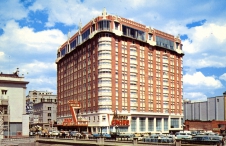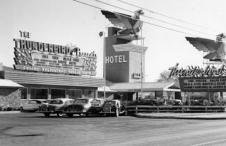Four Queens and Fremont
[VR Morph by Howard Goldbaum]
When the first photo in this montage was taken, Fremont Street looked much as the railroad intended: a line of businesses with the depot at the end. Now, Fremont Street is "Glitter Gulch," where the neon shines bright. Obviously, paving the street helped—the Union Pacific and its subsidiary, the Las Vegas Land and Water Company, only finished that project in 1925, two decades after the promised completion date.
Yet Fremont Street looked nothing like its shape at the end of this multimedia presentation until the mid-1990s. The Fremont Hotel became downtown's first high-rise in 1956. Its builder was Eddie Levinson, a co-owner of the Sands and later of Binion's Horseshoe who later faced federal charges and became embroiled in a political scandal involving Lyndon Johnson confidante Bobby Baker. The fifteen story, 155-room Fremont cost $6.5 million to build, and its investors included Lou Lurie, a San Francisco and Miami businessman whose son Bob later owned the San Francisco Giants baseball team.
The Fremont was historic in other ways. It soon expanded, adding a fourteen story tower, a 650-seat theater, and one of downtown's first parking garages. It offered downtown Las Vegas's first big-name entertainment, culminating in 1959 with the hiring of lounge performer Wayne Newton, who went on to a storied entertainment career, especially in Las Vegas. The Fremont also housed a television station, KSHO-TV-13, which went on the air in 1956 and was owned by Morry Zenoff, a local newspaper publisher. Its announcing staff included Bob Bailey, an African American entertainer and civil rights activist who had to enter the hotel through the back door and at one time was not allowed to appear on the air.
Eventually, the Fremont became part of the Argent Corporation, which turned out to be a front for organized crime families in Chicago, Kansas City, and Milwaukee. The Nevada Gaming Control Board and Gaming Commission forced out owner Allen Glick and the next owners, Al Sachs and Herb Tobman, when some of their employees were accused of continuing to funnel money to the mob. The state asked Boyd Gaming to run the hotel-casino, secure in the knowledge that founder Sam Boyd and his son, attorney Bill Boyd, were free of mob taint. The Boyds eventually bought the property. Not only does Boyd Gaming still own it, but the corporation built a bridge between the Fremont and another of its properties, the California Hotel and Casino, which in turn connects to another Boyd property, Main Street Station.
On the left at the conclusion of the presentation is another downtown casino with historic connections. The Four Queens opened in 1966. Its owner was Ben Goffstein, a onetime employee of William Randolph Hearst's newspapers who was involved in circulation wars in several cities; these wars were particularly rough, and Goffstein acquired a reputation for organized-crime connections. He was part of the team that took over the Flamingo after Bugsy Siegel's death, and he later moved on to the Riviera. Goffstein named the $5 million property for his four daughters. His wife Dottie, a onetime showgirl who was active with her husband in such community organizations as the Variety Club, served as the hotel-casino's interior designer.
In the early 1970s, after Ben Goffstein's death, the Four Queens became part of the corporate era of Nevada gaming. The Hyatt hotel chain bought it and ran it under a subsidiary, Elsinore. When the hotel's president, David Hood, died in 1977, his wife, Jeanne Hood, succeeded him, becoming one of the few women to serve as the president and chief executive of a Las Vegas hotel-casino. In 2002, Elsinore sold the Four Queens to Terry Caudill, who operates the Magoo's restaurant chain in Las Vegas. Since Goffstein opened the Four Queens in 1966, the hotel has grown to nearly seven hundred rooms with a 32,000-square-foot casino.
Meanwhile, Jeanne Hood was and remains an advocate of downtown redevelopment, exemplified by what appears at the top and bottom of the final shot. The Fremont Street Experience towers above the two hotel-casinos. Below, the street that the railroad took so long to pave now is covered with tile, befitting a pedestrian mall.
Article Locations
Related Articles
Further Reading
None at this time.


